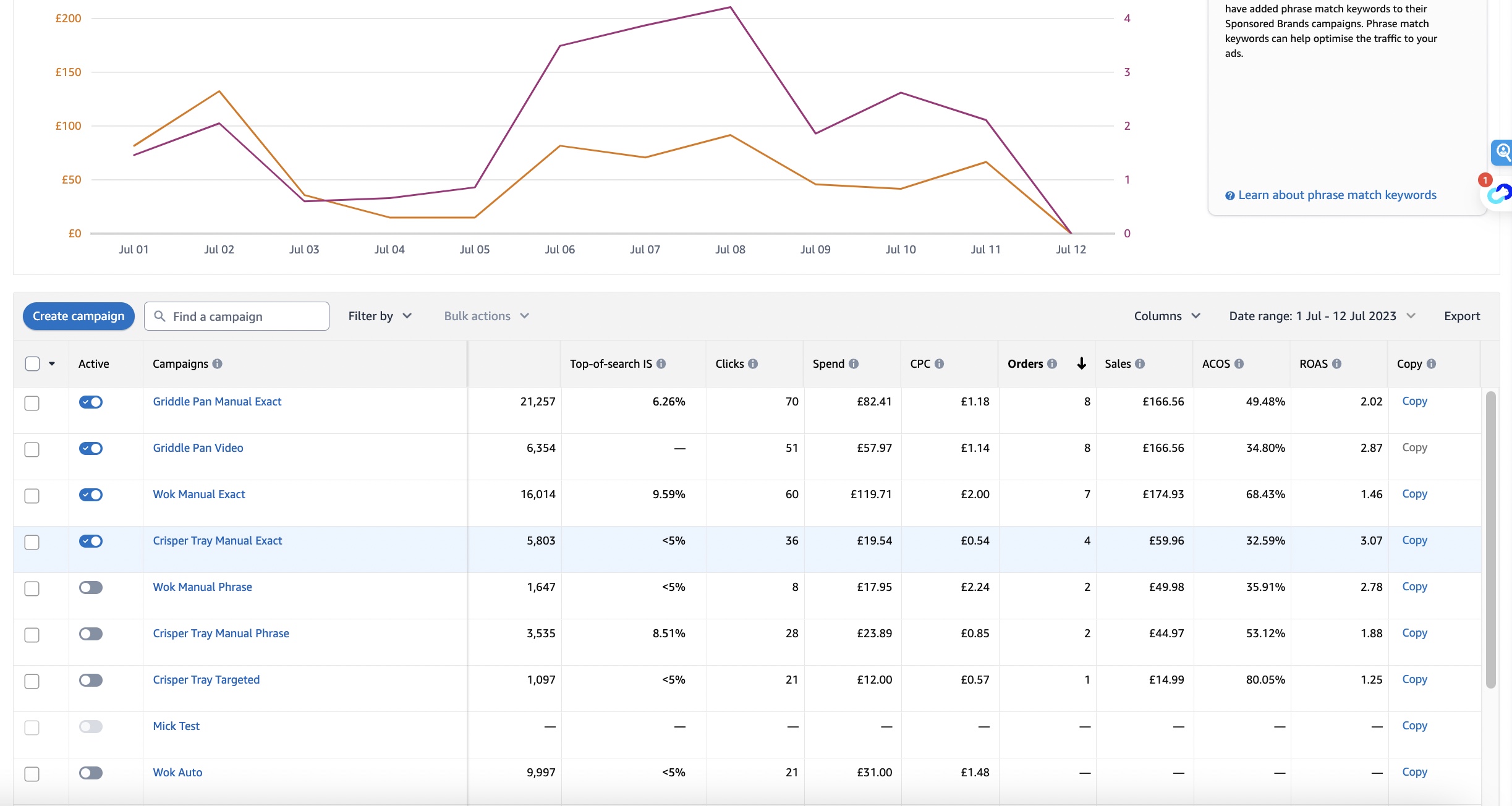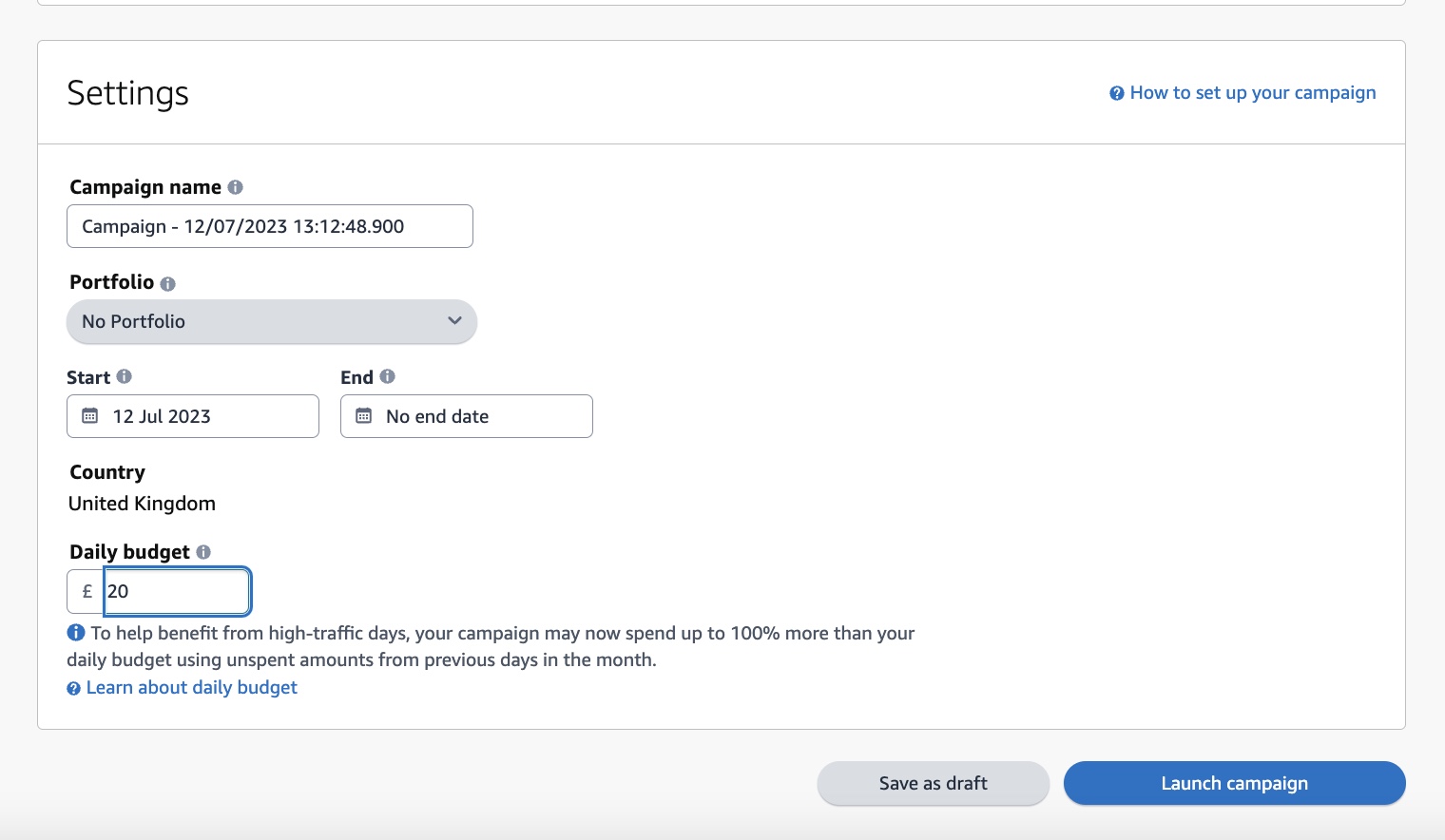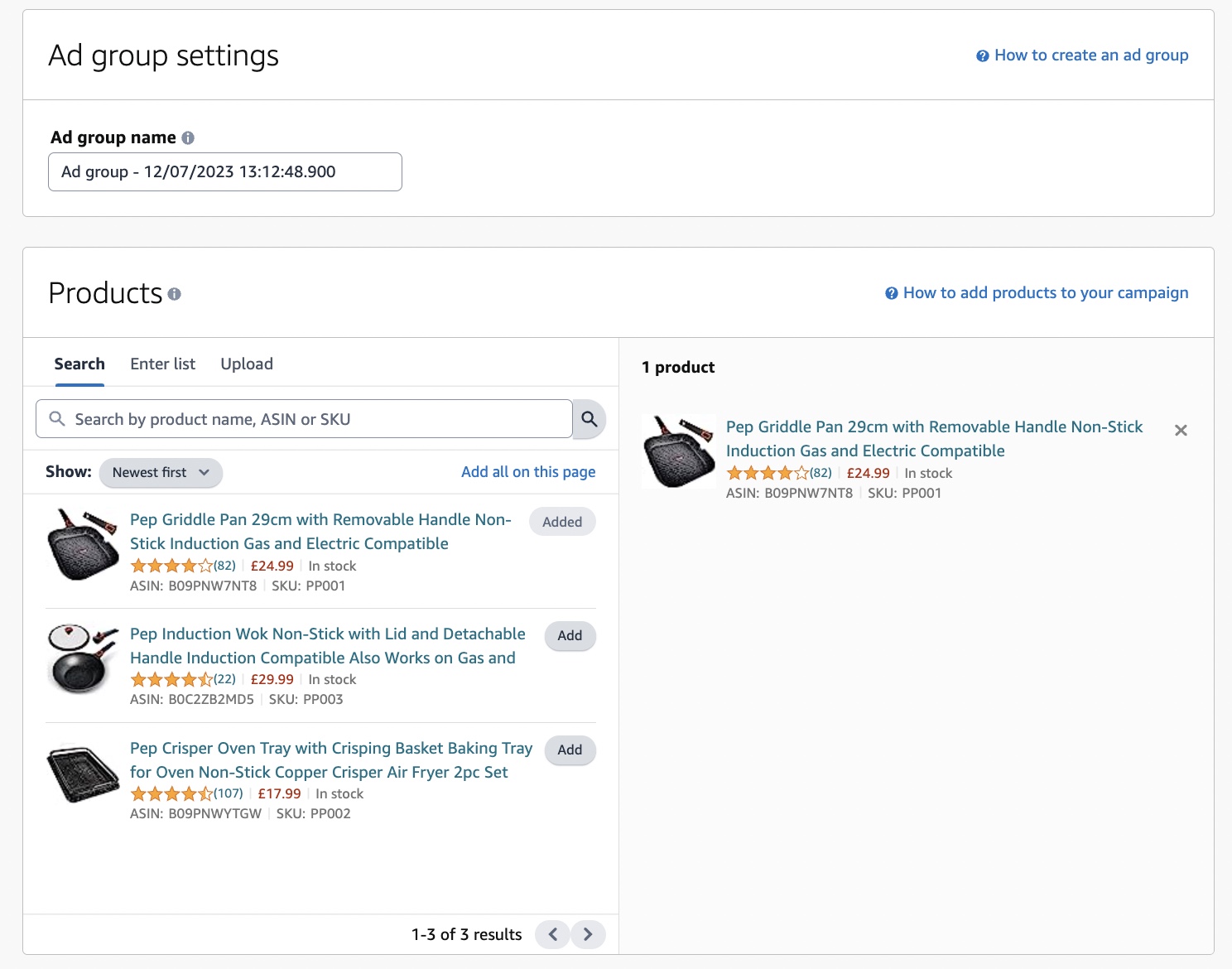It is estimated that the UK plays host to approximately 281,257 Amazon sellers with the e-commerce giant responsible for 5.5% of UK-based ecommerce sales. In such a competitive environment, maximizing visibility and sales requires a clear understanding of sponsored ads on Amazon.
Amazon Sponsored Products, in particular, is a powerful tool that can enhance your product visibility, target specific audiences, and increase sales on the platform.
This guide explores the world of Amazon-sponsored listings, including their benefits, how to set up a Sponsored Product campaign, and strategies for thriving on the platform.
What Are Amazon Sponsored Products & How Do They Work?
Amazon Sponsored Products are a cost-per-click (CPC) advertising program that allows sellers to promote their products within the marketplace. As of 2022, the median CPC for these ads in the UK stood at £0.57.
It allows sellers to increase the visibility and discoverability of their products, boosting their overall business performance.
At Seller Presto, we offer bespoke ads management services to help you navigate this process and get the most from your advertising spend. Get in touch to find out more.
Here’s an overview of how Sponsored Products on Amazon work.
Keywords & Products
As a seller, you start by choosing keywords to target. These keywords are what you want your product to rank for in Amazon search results. Keyword selection should be based on prior keyword and market research. Amazon offers its own keyword tool that you can use, but others such as the Helium 10 keyword tool are highly effective.
You can also select specific products you want to advertise (as long as your products comply with Amazon’s seller guidelines). These ads appear within relevant search results and on product detail pages, making them visible to potential customers searching for related keywords.
Bidding
While setting up your campaign, you specify how much you’re willing to spend per click on your ad. Higher bids increase your chances of securing a top spot, while lower bids might result in your ads not appearing at all.
Ad placement is determined through an auction-based system. An auction takes place whenever a customer searches Amazon using keywords related to your advertisement.
Factors like ad relevance, bid amount, and budget are considered in the auction. If you win the auction, your ad is displayed to the customer. You pay a small fee when a customer clicks on the ad, ensuring that you only pay when your ad generates engagement.
Ad Placement
Amazon Sponsored Products can appear at the top, along the side, or throughout relevant search results pages. They can also show up on competing or similar products’ detail pages.
Despite looking similar to organic listings, Sponsored Products ads are subtly marked as “Sponsored” to differentiate them from organic search results.

Description: Searching “coffee maker” on Amazon yields a row of sponsored products, followed by organic search results. Source

Description: Scrolling down on a coffee maker product listing, you can see additional Sponsored Products listed below. Source
Targeting Options: Automatic vs. Manual
When you set up your Sponsored Products ad, you’ll choose from automatic or manual targeting. Understanding the difference is important for new sellers, so here’s what you need to know.
Automatic Targeting
Automatic targeting allows Amazon to automatically match your ads with relevant search terms, product categories, and customer interests. It essentially lets Amazon take care of the keyword targeting. Here’s how it works:
- Keyword Matching: Amazon’s algorithm matches your product listing with relevant customer search terms. It determines relevance by considering factors like your product titles, descriptions, and backend keywords
- Match Types: With automatic targeting, your ads can appear for a broad range of relevant search terms, including close matches, loose matches, substitutes (targeting users looking at similar products sold by other brands), and complements (targeting users looking at the detail pages of products that would complement your product). This can increase your ad’s visibility but may also make it appear for less relevant queries
- Automatic Bidding: When using automatic targeting, you set a maximum bid, and Amazon’s algorithm automatically adjusts your bid based on the competitiveness and performance of keywords. This helps optimise your ad spending to maximise impressions and conversions
Manual Targeting
Manual targeting gives you much more control over your advertising campaigns by letting you manually select the keywords or product attributes you want to target. Here’s what you need to know about manual targeting:
- Keyword Selection: As a seller, you choose the specific keywords that you believe are most relevant to your product. These will be based on your keyword research and competitor analyses
- Match Types: Manual targeting allows you to choose from different match types for your keywords, such as broad match, phrase match, and exact match. Each match type determines how closely the customer search term must match your selected keyword to trigger your ad
- Bid Management: With manual targeting, you have fine control over setting and adjusting bids for each keyword. You can prioritise higher bids for more competitive and successful keywords, for example
- Negative Keywords: Manual targeting also lets you add negative keywords to your campaign, preventing your ads from appearing for specific search terms. This helps you fine-tune your targeting and avoid paying for irrelevant clicks
Keep in mind that manual targeting requires more time and effort than automatic targeting, especially when it comes to keyword research. However, by utilizing the right tools and strategies, you can find high-performing keywords that will help your products reach the right audience.
So which option should you pick? That depends on your advertising goals, experience, and budget. Automatic targeting can be a useful first step for discovering new keywords and reaching a broader audience, while manual targeting allows for more precision and control.
A common strategy is to start with automatic targeting to gather data on keywords that perform well and then switch to manual targeting to optimise your campaigns based on those insights.
As we’ll later discuss, regular monitoring, analysis, and refinement are the keys to success with Amazon Sponsored Products.

Benefits of Amazon Sponsored Products
Unlike Sponsored Brands, Sponsored Brands Video, or Sponsored Display ads, you don’t need to be brand registered to use Sponsored Products ads. This makes them the most popular ad type on Amazon, with a staggering 77% of third-party sellers choosing to use Sponsored Products ads.
Used strategically, Amazon Sponsored Products can be hugely beneficial for sellers. Amazon reports that in 2021, ASINs saw an average weekly increase of +50% across units ordered within the first year after launching a Sponsored Products campaign.
Aside from the potential sales boost, here are some of the major benefits of Sponsored Products:
- Increased Visibility: Sponsored Products Ads can boost sales for newly launched products. By featuring in search results and on product detail pages, your ads reach a larger audience, enhancing brand awareness and engagement
- Simplicity and Effectiveness: Sponsored Products Ads are user-friendly, making them ideal for sellers with little or no advertising experience. The Campaign Manager offers a comprehensive interface, detailed reporting tools, and automation options, simplifying campaign management for all sellers
- Maximised Advertising Budget: The pay-per-click model ensures you only pay when a shopper clicks on your ad. This allows you to control your advertising budget and optimise your ROI by focusing on the most effective keywords and bids
- Boosts Organic Rankings: Successful Sponsored Products campaigns can enhance your organic rankings on Amazon, further supporting your business goals. Increased visibility, sales, and customer engagement from your ads can improve your products’ performance and provide long-term benefits
- Valuable Insights: Amazon provides insights into clicks, new customers, impressions, and advertising spend, among other important metrics, that can help optimise your campaigns
How to Set Up Amazon Sponsored Products
Amazon makes it easy to set up a Sponsored Product campaign, even for those with no previous advertising experience. Here’s a step-by-step guide.
Choose Your Products to Advertise
Select the products from your catalogue that you want to advertise. Ideally, choose products with strong sales potential, high demand, and competitive pricing. It’s a good idea to start out by focusing on a small selection of products whilst you get used to the platform.
Choose Your Seller Account
Select the seller account for which you want to create the campaign.
Select Your Campaign Type
Go to the Advertising tab within Seller Central, select “Campaign Manager,” and start a new campaign. Choose “Sponsored Products” from the available campaign types.

Description: Here you can see the page where you can view and manage all of your Sponsored Product campaigns.
Set Your Campaign Name
Choose a name that clearly identifies the purpose or products of the campaign so it’s easy for you to identify and track.
Define Your Campaign Duration
Next, set specific start and end dates for your campaign to run.
Choose Your Daily Budget
Set your daily budget for your campaign. This should align with your advertising goals and overall business strategy.

Description: Here’s where you’ll name your campaign, set the duration, choose your daily budget, and decide between manual and automatic targeting.
Create Ad Group
Ad groups help you better organise your campaign and group multiple Sponsored Products under one umbrella. You can group products by theme, keywords, and performance. Create an ad group and give it an easy-to-identify name.

Description: After creating and naming your ad group, you can choose the products to include in the group.
Select Your Targeting Method
Now, choose between manual targeting (you choose the keywords or products to target) or automatic targeting (Amazon targets your ads based on your product’s information).
If you select manual targeting, you’ll have two further options:
- Keyword Targeting: Add relevant keywords from your keyword research that are highly searched by customers and align with your product
- Product Targeting: Instead of selecting keywords, you can target your ads based on specific product attributes, such as brand, price range, or star ratings. This approach allows you to reach customers with specific preferences
Set Your Keywords/Product Targeting
If you’ve chosen manual targeting, Amazon will give you a list of suggested keywords. Of course, you can also input your own keywords here. Then, you can choose “broad”, “phrase”, or “exact” match types.
Don’t forget to add negative keywords as well. These are keywords that you don’t want your product to appear for in search results.
Set Your Bids
Now it’s time to set your bids for each keyword. Amazon will provide bid suggestions for you, but with manual targeting, you can customise them to fit your budget and goals.
Decide how much you’re willing to pay when a shopper clicks on your ad. It’s advisable to start with a conservative budget, track your campaign’s performance, and adjust the budget accordingly.

Description: Here’s where you’ll customise your bids for each keyword in your campaign.
Review and Launch Your Campaign
Review all of the settings and details of your campaign to ensure everything is correct. Once everything looks good, click “Launch Campaign.”
Track performance
Regularly monitor your campaign’s performance using Amazon’s reporting tools. Within the Campaign Manager, you can run detailed reports and track metrics such as impressions, conversions, click-through rates (CTR), and advertising cost of sales (ACoS).
Analyse the data to identify top-performing keywords. Then, adjust your bids, tweak the negative keywords that you are using, and further optimise your campaign to improve performance and ROI.
If you’re running an automatic targeting campaign, regularly review the keywords Amazon has chosen to target. One strategy is to take your best-performing keywords from an automatic campaign and add them to a manual campaign, where you can increase your spend on keywords that perform the best and lower your spend on keywords that aren’t generating results.
Regularly review campaign performance to make data-driven decisions and adapt your strategy based on the results.

If you’re looking for help with your Amazon paid advertising campaigns, get in touch today. Seller Presto manages campaigns across a portfolio of businesses, optimising each campaign to ensure that its clients extract as much value from their paid advertising budgets.
Integrating Amazon Sponsored Products into Your Marketing Strategy
Amazon Sponsored Products play a vital role in your comprehensive online marketing strategy, complementing and enhancing your other marketing initiatives. Here’s how you can effectively blend Amazon Sponsored Products with other marketing channels:
- Align With Business Goals: Your Amazon Sponsored Products campaigns should align with and support your overarching business objectives
- SEO Integration: Coordinate your Amazon ads with your Amazon SEO strategy. Identify keywords that generate organic traffic to your product listings and incorporate these into your Sponsored Products campaigns. Use the insights from well-performing keywords to inform and refine your overall SEO strategy. As your product gains Amazon SEO equity, you can strategically reduce paid advertising expenditure on well-ranking keywords, redirecting the focus onto other keywords or product listings
- Email Marketing: Incorporate links to your Sponsored Products in your email campaigns, including high-quality product images and persuasive copy in your newsletters or promotional emails
- Social Media Marketing: Leverage your social media platforms to promote your Amazon listings. Craft engaging posts, videos, or stories that highlight your product’s unique features and benefits, and provide a direct link to the respective Amazon product page
- Retargeting/Remarketing: Utilise Amazon’s retargeting options for your Sponsored Products, promoting your products on off-Amazon sites to customers who have previously engaged with them to encourage conversions
- Seasonal Campaigns: Leverage Sponsored Products for your seasonal promotions. Set up advertisements for seasonally relevant products that you predict will perform well during specific times of the year
- Content Marketing: Develop informative and engaging website content such as blog posts, guides, and reviews that showcase your sponsored products’ benefits and features. Ensure to include links to the respective listings on Amazon
- Optimization: Regularly monitor and A/B test your ad campaigns using Amazon’s performance reports. The insights gained can be crucial for optimizing other marketing efforts
Remember, incorporating Amazon Sponsored Products into your marketing strategy isn’t about shifting your entire focus to Amazon. It’s about integrating this tool as a part of a diverse, multi-channel marketing approach.
Common Mistakes to Avoid
As you prepare to launch your own Sponsored Product campaign, ensure you’re mindful of the common pitfalls new sellers often encounter. Here are some frequent mistakes to steer clear of with Amazon’s Sponsored Products:
- Ignoring Negative Keywords: Failing to use negative keywords can result in irrelevant ad displays and unnecessary spending
- Setting and Forgetting: Neglecting ongoing monitoring and adjustment of campaigns may lead to missed optimization opportunities
- Overly Broad Keywords: Using vague, non-specific keywords can attract unqualified traffic, escalating costs
- Inadequate Budgeting: Setting a budget that is too low may limit your ad exposure and campaign effectiveness
- Not Testing Ad Elements: Failure to perform A/B testing on ad elements can result in less-than-optimal ad performance
- Poor Product Detail Pages: Neglecting the quality of product detail pages can negatively impact conversion rates. Check out our guide on Amazon listing optimization to improve your product detail pages
- Ignoring Performance Reports: Failure to utilise Amazon’s reporting tools to track and optimise campaigns can hinder your ability to enhance campaign performance
Conclusion
Amazon’s advertising features have emerged as crucial marketing tools for e-commerce sellers in the UK. When integrated into a comprehensive digital marketing strategy, they present opportunities to amplify product visibility and drive sales within Amazon’s vast marketplace.
Embracing a culture of experimentation and adjustment is crucial for leveraging these tools effectively. The success of Sponsored Products campaigns relies on the continuous optimization of your strategy based on performance data. By diligently monitoring the performance of your ads and implementing necessary improvements, you can fine-tune your targeting, keyword selection, and bidding strategies to maximise your campaign’s returns.
Understanding how to utilise Amazon-sponsored ads paves the way for improved business performance. Harness the power of Sponsored Products to stay competitive and enhance your bottom line.
We appreciate that for many business owners, managing paid advertising campaigns can be difficult, soaking up precious time. Seller Presto – one of the leading UK-based Amazon marketing agencies – is here to help, offering a full suite of Amazon account management services. To find out more, get in touch today.
FAQs
Who can use Amazon Sponsored Products?
Professional sellers, book vendors, and KDP authors and agencies can use Sponsored Products. The products must fit in with Amazon’s eligible categories and they must be eligible for the Buy Box.
How are Amazon Sponsored Products different from other Amazon ads?
While other ad formats, such as Sponsored Brands or Sponsored Displays, focus on brand or product category promotion, Sponsored Products allow you to target specific products in your store. Sponsored Products lets you leverage keywords, search terms, and customer interests to display relevant ads, making them highly targeted and effective in driving traffic and conversions for individual product listings.
Also, unlike Sponsored brands or Sponsored Display ads, you don’t need to be Brand Registered in order to use Sponsored Products.
Can I control how much I spend on Amazon Sponsored Products?
Yes, Sponsored Products operate on a pay-per-click model, which gives you a lot of control over how much you spend. You can choose the maximum amount you want to spend on a click and the maximum amount you want to spend in a day.
What are negative keywords, and why are they important?
Setting negative keywords can be extremely helpful in your Sponsored products campaign. If you set negative keywords on a manual targeting campaign, your product won’t appear for those queries. You may want to do this because certain keywords just aren’t converting well, or they are irrelevant to your product.
What is ACoS, and why is it important?
Amazon advertising cost of sales (ACOS) is a helpful metric that compares the amount you spend on pay-per-click ads versus the amount you earn. It can tell you how cost-efficient your campaigns are in order to help you improve and save money on advertising spend.



